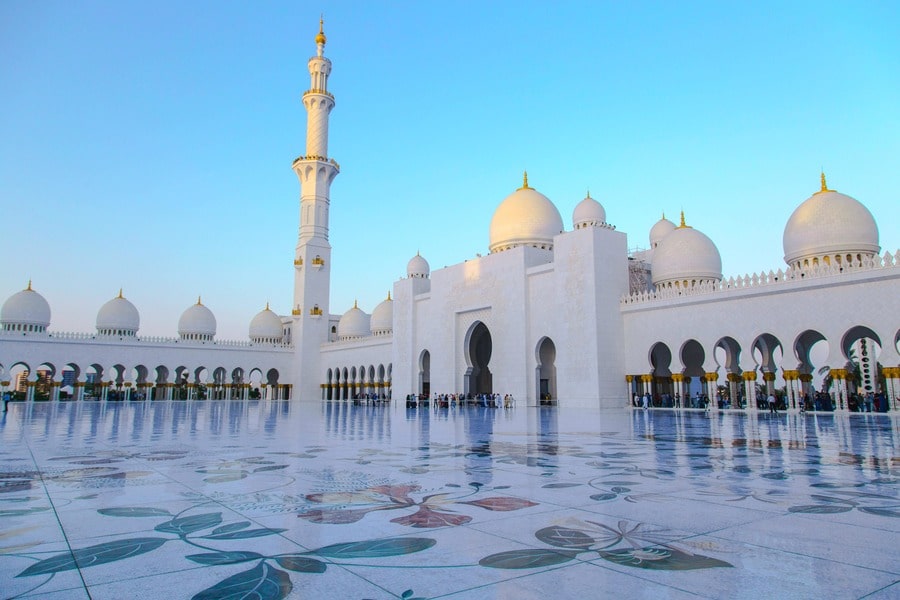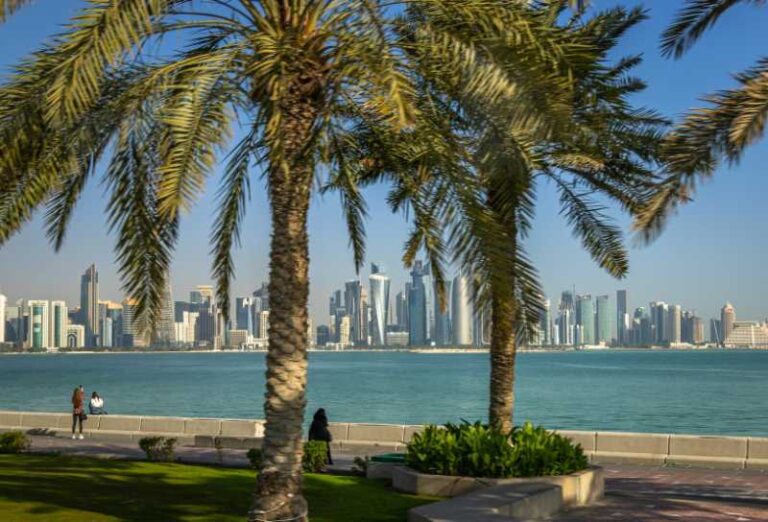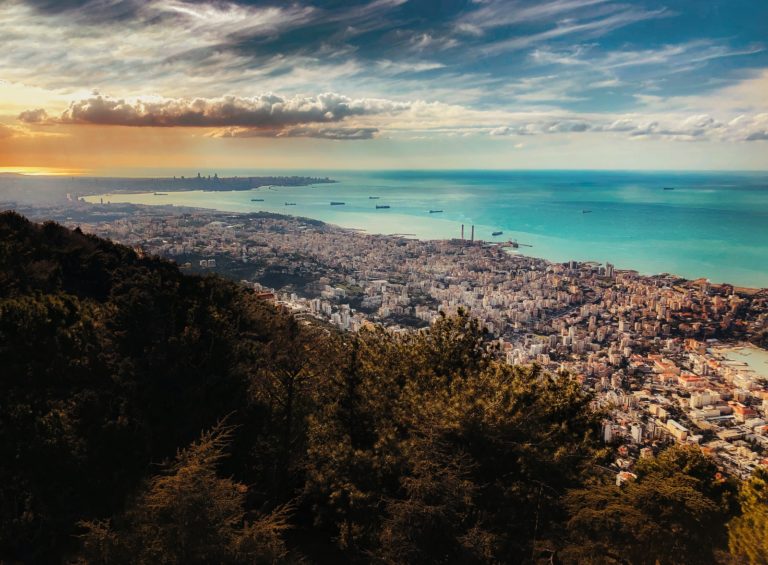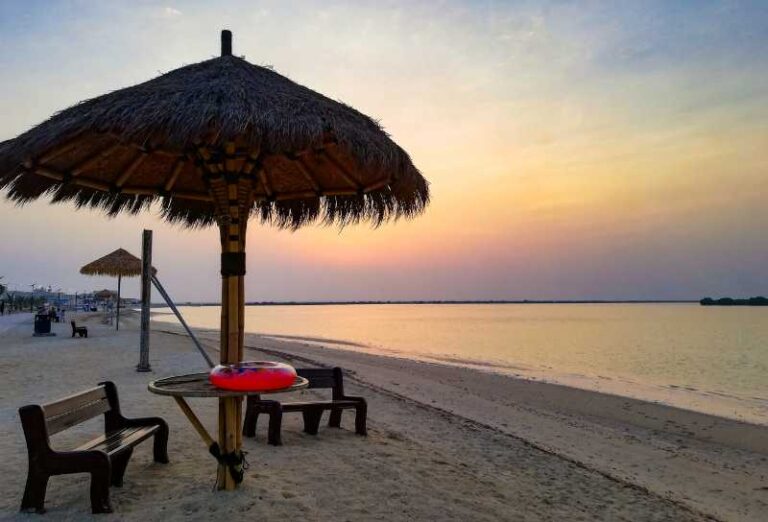UAE Travel Guide

Located on the Arabian Peninsula, the United Arab Emirates (UAE) is one of the most affluent and most-visited nations in the Middle East.
While many visitors stick to the well-known hotspots of Dubai and Abu Dhabi, those who venture away from the tried-and-trodden track will find a completely different world that feels almost undiscovered by tourism.
Many people associate the nation with the oil industry, gleaming shopping malls, and opulent mosques.
The country has so much more, however, to offer to visitors, from history, culture, and modern delights, to splendid nature, gorgeous architecture, and thrilling adventure activities.
Here’s everything that you need to know when planning a trip to the United Arab Emirates
Table of Contents
Geography and Climate in the UAE

Geographically part of Western Asia and part of the Middle East region, the United Arab Emirates shares land borders with Saudi Arabia and Oman, as well as a short disputed land border with Qatar.
The nation also claims several islands, some of which are currently in dispute. The country has a long stretch of coastline along the Persian Gulf as well as a shorter coast along the Gulf of Oman.
The UAE is made up of seven distinct states, known as emirates, each with its own culture, landscapes, atmosphere, and defining features.
The seven emirates are Abu Dhabi (home to the nation’s capital city), Dubai, Sharjah, Ajman, Fujairah, Umm Al Quwain, and Ras Al Khaimah. Abu Dhabi is the biggest emirate, while Ajman is the smallest.
A hot and arid country, the UAE has large areas of desert and sand dunes. There are a number of significant oases throughout the desert areas, enabling human habitation to have grown.
There are huge salt pans along much of the country’s coastline. Inland, the country has high mountains.
The desert climate means that the country has hot summers and warm winters. July and August are the hottest months, when temperatures can top 50 degrees Centigrade (122 degrees Fahrenheit).
January and February are typically the coolest times of the year, with temperatures of around 12 degrees Centigrade (54 degrees Fahrenheit).
Temperatures are often lower in the higher elevations of the mountains than along the coast and in the deserts.
The mountains also often see larger amounts of rain than in other parts of the country. Along the coast, the most rains fall in the summer, although there are usually only a few rainy days per year.
Towards the end of summer, a humid wind blows across the land from the sea. Dust storms and sand storms can occur in coastal and desert areas.
Although far from common, snow and hail have been recorded in the mountains.
Generally, the best time to visit the United Arab Emirates is from October to March, when temperatures are low enough to be comfortable and humidity is an a minimum.
Average temperatures during this period are between 15 and 27 degrees Centigrade (63-85 degrees Fahrenheit). Days are typically long and sunny.
Culture in the UAE
The region has a long history and the population is diverse.
Demographically, there are many more expats than local Emiratis living in the country; around 20% of the population is true Emirati.
Plus, the tourism industry attracts temporary short-stay visitors from all across the globe.
Large expatriate groups include people from India, Bangladesh, Pakistan, Sri Lanka, the Philippines, and Malaysia, with significant numbers also from various European countries, Australia, the USA, and Canada.
Dubai, Abu Dhabi, and Sharjah have the most demographic diversity, while smaller and lesser-visited states are often comparatively more traditional.
Although the official language of the UAE is Arabic, English is widely spoken along with other global languages.
Because each of the seven emirates retains a degree of self-rule and autonomy, daily life and customs can vary across the country.
To some extent, the culture of the United Arab Emirates has been heavily influenced by various immigrant groups.
That said, the country is still very much influenced by religion. The official religion of the UAE is Islam.
While certain parts of the country are among some of the most liberal places within the Islamic world, visitors and expats must still be aware of the strong religious practices and traditions that are part of everyday life.
Standards of Dress in the UAE
Visitors are not required to wear the hijab, but it is not unusual to see local Emirati ladies wearing full Islamic dress.
Local ladies often wear a long, loose rode known as an abaya and a head scarf. The typical dress for Emirati men is a long robe known as a kandoura and a white or checked ghutra head covering.
Although visitors are not required to fully cover their bodies, people should remember to dress conservatively and modestly to avoid offending locals and possibly also getting into trouble.
For women, this means no short or see-through clothing and arms covered.
Western-style swimwear is also not appropriate for public beaches; bikinis and bathing suits should only be worn at private swimming pools at, for example, hotels.
Men should not walk around shirtless, and tank tops are not advised.
Alcohol in the UAE
Unlike in many other Islamic nations, alcohol is widely available. People on tourist visas can generally purchase alcohol in shops, at restaurants, and in hotel bars.
Most non-Muslim residents will need to obtain an alcohol license to be able to purchase alcoholic beverages in stores throughout the emirates of Abu Dhabi, Dubai, and Ajman.
Alcohol is prohibited completely in Sharjah.In keeping with Islamic traditions, the weekend in the UAE is on Friday (the Islamic holy day) and Saturday.
Many businesses close on Fridays and locals visit the mosques.
Festivals in the UAE
Major holidays in the UAE include Commemoration Day and National Day as well as the religious holidays of Eid al-Fitr and Eid al-Adha.
Muslims fast during the holy month of Ramadan; dates change each year as it is based on the lunar calendar.
During Ramadan, many restaurants are closed during the daytime, with people breaking their fasts at sunset.
Visitors should avoid eating, drinking, and smoking in public at this time. Nightlife is limited at this period.
Food in the UAE
When it comes to cuisine in the UAE, Emirati staples include meat (most commonly lamb, mutton, goat, and beef), fish, bread, and rice.
Traditional dishes include the Saudi-born rice dish of kabsa, the wheat-based porridge-cum-soup dish of harees, quzi, which has Iraqi roots and consists of lamb dried fruit, and nuts served on rice, falafel (made from chickpeas), and shawarma.
Various immigrant group have also brought their own gastronomy to the UAE, so Turkish, Indian, Bangladeshi, Yemeni, Pakistani, and Syrian dishes are also fairly common place.
Top Things to See and Do in UAE
The United Arab Emirates has a rich diversity of things to see and do, with an abundance of sights and activities to suit almost every type of traveller.
As already mentioned, each emirate offers a different experience, so it’s well worth planning to visit at least a couple of different states for a more-rounded view and experience of the nation.
Abu Dhabi
the largest emirate and home to the country’s capital, Abu Dhabi is a modern and bustling destination. The city of Abu Dhabi is home to many international embassies and global companies.
A fabulous place for lovers of all things luxurious, the city boasts magnificent shopping centres, decadent hotels, lush gardens, and sleek architecture.
There are plenty of opulent air-conditioned malls where you can escape the heat and spend days browsing in high-end retail outlets.
Some of the most popular malls in Abu Dhabi include Marina Mall, which is home to a glorious musical fountain and water features, Abu Dhabi Mall, and Khalidiya Mall.
Alternatively, browse for bargains and traditional goods, including carpets, perfumes, and spices, at the eclectic and busy souks.

One of the city’s must-sees is the striking Sheikh Zayed Mosque. The enormous pale building is the biggest mosque in the United Arab Emirates and visitors can join guided tours to marvel at the interiors.
Gaze up at the soaring flagpole on Marina Island, one of the loftiest such poles in the world, admire the views along the stretching Corniche, and relax on sandy beaches.
You can also take boat trips along the water for a different perspective of the city.
Unwind and enjoy varied leisure activities in beautiful parks such as Al Safa Park and Khalifa Park, and peer into the nation’s past at the Heritage Village.
Marvel at the architectural splendour of the Emirates Palace hotel, meet birds of prey at Abu Dhabi Falcon Hospital, and step back in time at Qasr al-Hosn.
Art lovers shouldn’t miss seeing the masterpieces within the Louvre Abu Dhabi.
Snap pictures of the attractive Qasr al-Watan, learn more about the country’s past and present at the informative Zayed National Museum, and soak up the views from the Marina Eye.
There are several islands, both natural and man-made, at the fringes of the city.
Feel the thrill at the exciting Ferrari World, see the country’s Formula One track, and cool down in the heat at Yas Waterworld, all located on Yas Island.
You’ll find pleasant beaches and a top-glass golf course on Saadiyat Island. If you visit in the winter months, the camel races (held on Thursdays and Fridays) are exciting.
Located next to the border with Oman, Al Ain is a pretty oasis town within the emirate of Abu Dhabi.
Nicknamed the country’s Garden City, it offers more peace and quiet in nature than the hectic capital.
Wander through the shade of the date palms that surround the magical Al Ain Oasis, soak in the hot springs of Green Mubazzara, gaze up at Jebel Hafeet (the second-highest mountain in the UAE), and travel to the top of the mountain for spectacular vistas.
At the foot of the mountain there are a number of caves to tempt explorers too.
For even more fun and thrills, check out Wadi Adventure, complete with kayaking, climbing, zipling, surfing, rafting, and more. Al Ain Museum and Fort provides an interesting look back through time.
Wathba Wetland Reserve is a top spot for keen ornithologists, home to more than 250 avian species.
Abu Dhabi’s mangroves also offer an exciting glimpse into the natural world, and you can easily spot the local wildlife with a kayaking trip.
The tranquil Liwa Oasis is another popular destination within the western part of Abu Dhabi Emirate.
Situated in the dry and dusty Rub’ al Khali, also known as the Empty Quarter, the oasis is a tranquil spot in the world’s biggest uninterrupted sandy desert.
Surrounded by rugged terrain, the area is famous for growing dates. Bedouin groups still live a traditional way of life and there are a number of camel farms open to visitors.
Explore the mighty sand dunes and climb the towering Moreeb Dune.
Other desert adventures include quad biking, dune surfing, and dune bashing.
There are several old fortresses scattered around the area and watching the sun set over the desert is a romantic thing to do. You can opt to camp under the stars for a once-in-a-lifetime experience.
Dubai
Dubai is the second-largest emirate in the UAE and a major tourist destination.

Famous for glamorous shopping, lavish accommodations, and stunning architecture, it is home to the tallest tower in the world: the dazzling Burj Khalifa.
The sprawling city of Dubai is divided into several districts; Dubai Marina, Jumerirah, Dubai Creek, Bar Dubai, Deira, and Bluewaters are some of the most appealing areas for visitors.
The mega malls are a highlight for many visitors, with spectacular architecture, delicious food options, entertainment, and a sense of luxury as well excellent shopping.
Some of the most popular malls include the enormous Dubai Mall (the largest in the city), the Mall of the Emirates, Wafi Mall, Ibn Battuta Mall, and Town Centre Jumeirah.
If shopping is one of your main reasons for visiting Dubai, try to arrange your trip to coincide with the annual Dubai Shopping Festival, held each January.
The bustling souks offer even more retail therapy, along with a glimpse into a more traditional way of life. Practice your haggling skills at the Spice Souk and the Gold Souk.
Admire the gleaming Burj Khalifa from afar before riding to the observation deck of the world’s tallest tower for amazing views. Take pictures of the impressive
Burj al-Arab, billed as the only six-star hotel on the planet, and be wowed by the spectacular show at the Dubai Fountain.
Walk around the marina and admire at the luxurious yachts that float in the waters and take a trip along Dubai Creek on a traditional dhow sailing vessel.
Riding along Dubai Water Canal is also popular. Wild Wadi Park and Aquapark, within the glorious Atlantis Hotel, are family-friendly attractions that offer heaps of fun and respite from the heat.
Other child-friendly attractions include Dubai Dolphinarium, the gigantic Dubai Aquarium and Underwater Zoo, Legoland Dubai, IMG Worlds of Adventure, and the Museum of Illusion.
Enter the world of film and TV at Motion Gate and Bollywood Park, kick back at the Miracle Gardens and Al Safa Park, and experience the novelty of skiing while surrounded by desert at the ski centre inside the Mall of the Emirates.
Peer into the past with a stroll around the reconstructed Bastakiya District, travel back in time at the Heritage Village, discover more about the country’s developments and growth at the Dubai Museum, admire the works in Jameel Arts Centre, and marvel at the statuesque Jumeirah Mosque.
Other things to see in Dubai include the historic Al Ahmadiya School, the quirky Dubai Frame, Dubai Opera, and The Green Planet by Meraas.
Walk along sandy beaches, relax by hotel swimming pools, play golf, go fishing, enjoy diverse water sports, and take day trips to deserts, dunes, lakes, and waterfalls.
Sharjah
With Sretches of coastline along both the Persian Gulf and the Gulf of Oman, Sharjah is the third-largest emirate in the UAE.
Lying next to Dubai, it offers a pleasant change from the hustle and bustle of its neighbour.
Get a culture fix at Sharjah Museum of Art and Sharjah Museum of Islamic Civilization, appreciate the details of Al Noor Mosque
Discover more about the UAE’s history at Al Hisn Fort, and visit speciality museums like the Calligraphy Museum, the Classic Cars Museum, the Maritime Museum, Sharjah Archaeology Museum, the Academy of Astronomy, and Al-Mahattah Museum, which provides insights into the first airport in the Gulf Region.
Walk around the heritage area and admire the old and reconstructed buildings and be dazzled by the impressive King Faisal Mosque.
The ornate Russian Orthodox Church and St. Michael’s Catholic Church are also pleasant religious buildings.
There are plenty of chances to enjoy being outdoors too, with a selection of lovely parks and natural spots such as Al Nakheel Oasis, Khalid Lagoon, Al Mamzar Lake, and Wasit Nature Reserve.
Learn more about the country’s flora and fauna at the Arabia Wildlife Centre, bask on sandy beaches, and visit Sharjah Desert Park.
Take kids to the Butterfly Park, the Discovery Centre, and the fun indoor theme park of Adventureland.
The historic Al-Arsah Souk and the attractive Blue Souk are great places to browse and buy a wide selection of goods, and Al Qasba has a diverse selection of leisure and entertainment options.
The city of Khor Fakkan is an enclave with beautiful beaches, and other places of interest around the emirate include the seaside resort of Dibba al-Hisn, Kalba, and Al Dhaid.
Ajman
Ajman is the UAE’s smallest emirate. Especially popular with budget explorers and people who like to get away from the tried-and-trodden track, Ajman also appeals to nature lovers and fans of the great outdoors.
Observe numerous species of birds at Al Zorah Nature Reserve, go hiking in the Hajar Mountains, join a desert safari, and spot dolphins swimming in the sea.
Located in the historic Ajman Fortress, Ajman Museum is the ideal place to learn more about the emirate’s past.
You can snap pictures of superb mosques, walk along sandy beaches, dine along the Corniche, and stroll through verdant parks.
Fujairah
Previously part of Sharjah, Fujairah is the youngest of the emirates. It is primarily a business-focused city.
Separated from the rest of the country by the Hajar Mountains, it boasts some of the best beaches in the United Arab Emirates.
It is the best place in the UAE for scuba diving, and underwater explorers can marvel at a wide variety of aquatic life and see old shipwrecks.
The mountains are also great for outdoor adventures, speckled with dry rivers known as wadis, and you can soothe your muscles in some of the hot springs.
There are a few historic and cultural attractions in and around the city, including the 1670 Fujairah Fort, Bithna Fort, Awhlah Fort, and Al-Hayl Castle.
Travel a short distance outside of the city and you’ll find the small but significant Al-Bidyah Mosque; it is the oldest mosque in the country.
Other highlights include Fujairah Museum and the large Sheikh Zayed Mosque.
Ras Al Khaimah
A popular retreat from busy Dubai, Ras Al Khaimah is a comparatively more peaceful destination. It sits close to the Omani border and between the Persian Gulf and Hajar Mountains.
White sandy beaches meet clear blue waters, and fishing and diving are perfect activities for adventure lovers.
The nearby mountains are also great for outdoor fans, with hiking, scenic drives, climbing, and camping among the possibilities for active explorations.
It is also easy to reach the desert, where you can take part in activities like riding in dune buggies, desert safaris, and exploring dramatic dunes.
A walk around the old city reveals insights into the area’s past, with an old mosque, market, fort, and harbour.
Learn more about local history and culture at the Ras Al Khaimah National Museum and travel back in time at the remains of Sheeba’s Palace.
History lovers are also sure to enjoy discovering the prehistoric remains of Shimal, along with the forts of Dhayah and Falayah.
Take a trip to the ghost town of Jazirat al-Hamra, once a hub for the pearl industry, and walk around the abandoned harbour.
Follow the rugged road to the top of Jebel Jais, the tallest mountain in the UAE, and soak up the sweeping views.
If you’re feeling brave you can also take the plunge on the zipline, which is one of the longest on the world.
Have fun on the rides and slides of Ice Land Waterpark, soak in the thermal waters at Khatt Oasis, go bird watching in the small town of Rams, admire the scenic beauty of Wadi Bih, and see how traditional dhow boats are made.
Umm Al Quwain
The quietest of the country’s emirates, Umm Al Quwain is a great place for people who like to venture away from the beaten track.
It’s also a top spot for those who wish to see some of the UAE’s traditions.
Peek into the past as you browse the exhibits and displays at Umm Al Quwain Museum, housed within a reconstructed fortress.
Take a walk through the old harbour and you can see people making dhow boats, using techniques that have been handed down over the generations.
See homes that were built from coral and learn more about the city’s pearl industry.
Watch the camel races in the winter and see spectacular falconry displays throughout the year.
Falaj Al Mualla Garden Park, Happyland, and the city aquarium are perfect outings for families, while couples can enjoy some romantic moments with a stroll along the Corniche.
Visit some of the smaller islands for interesting mangroves, pleasant beaches, good bird-spotting opportunities, and an air of peacefulness.
Another fantastic trip is the oasis at Falaj Al Moalla.
There is definitely much more to the United Arab Emirates than many people realize!






